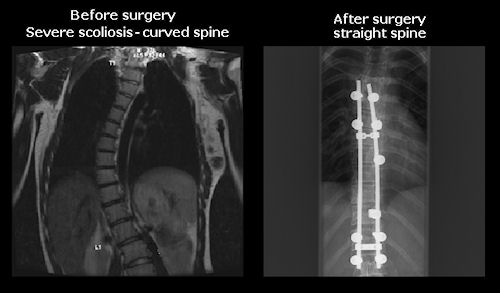Common Spine Conditions
Scoliosis is a common spine condition where the spine has an abnormal curvature and rotation.
The most commonly diagnosed cases of Scoliosis are idiopathic, which means the cause of the Scoliosis is unknown and there is no association with any other disease or disorder.
It is common for idiopathic scoliosis to develop in children aged 10-15 years of age but can also be diagnosed in younger children and babies, due to a birth defect.
Scoliosis may also be caused by other conditions such as Cerebral Palsy and traumatic spine/brain injury.
CASE STUDY: SEVERE SCOLIOSIS
The X-ray below shows a patient that had severe thoracic scoliosis. Scoliosis is an abnormal curve and rotation of the spine to one side, causing back pain and abnormal posture. The below image also shows the right lung was squashed to the rib cage.
At surgery the Scoliosis was corrected to nearly normal alignment and held with titanium screws, hooks and rods.


Classification of Idiopathic Scoliosis:
- Infantile: New born – 3 year old
- Juvenile: 4 year old – 9 year old
- Adolescent: 10 year old – Teen years
Other types of Scoliosis:
- Congenital: Congenital Scoliosis develops due to abnormalities in other areas of the body, such as heart and kidney.
- Neuromuscular: Disorders of the nervous system/brain such as muscular dystrophy can result in Scoliosis.
- Paralytic: Decreased spinal cord function such as paraplegia and quadriplegia can result in Scoliosis.
While there is no cure for scoliosis, there are a range of options for treatment of the condition. Early detection of scoliosis is an important factor in the treatment and management of the condition. Scoliosis can be defined by the shape/curve in the spine, the location of the curve and the magnitude of the curve.
Some common signs of Scoliosis are:
- Sideways curvature of the spine
- One higher, more prominent shoulder than the other
- Muscular pain
- Uneven hips and waist
- Unnatural body posture
- Discrepancy in length of limbs


